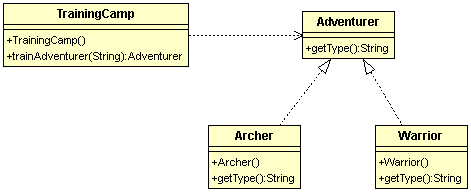簡單工廠模式 SimpleFactor
目的:定義一個簡單工廠,傳入不同的參數取得不同的類別物件
- 簡單工廠又稱為靜態工廠模式,一般來說同一工廠內所產生的類別會有一個共同的父類別(介面)
首先,先從新手村開始
簡單工廠模式是一種管理物件創建的模式,隨著輸入的參數不同,簡單工廠會回傳不同的物件,使用者取得物件的時候只要傳入正確的參數,不需要去理解這個物件。
現在要設計一個訓練冒險者Adventurer的訓練營Training Camp,裡面可以訓練的冒險者種類有弓箭手Archer、鬥士Warrior。套到簡單工廠模式中,訓練營就是我們的簡單工廠(SimpleFactory),冒險者則是產品的父類別(Product),弓箭手與鬥士為實體產品(ConcreteProduct)。如果有人要來招募冒險者組隊,只要跟訓練營說請幫我訓練一個冒險者就可以,不用去理解訓練過程。
現在新手村要多訓練一種冒險者,牧師Priest,只要在trainAdventurer方法內增加一個switch case分支就好。不過這樣直接修改TrainingCamp類別的程式碼,違反了開放/封閉原則,因此簡單工廠不能算是一個健全的設計模式,不過如果簡單工廠在小型的軟體架構中很好用,因此一般設計模式的教學都會從簡單工廠模式開始,實務上也常常會用到這個簡單的模式。
類別圖

程式碼
產品介面與實作類別
// 冒險者(Product)
public interface Adventurer {
//告訴別人你是哪種冒險者
String getType();
}
// 弓箭手(ConcreteProduct)
public class Archer implements Adventurer {
@Override
public String getType() {
System.out.println("我是弓箭手");
return this.getClass().getSimpleName();
}
}
// 鬥士(ConcreteProduct)
public class Warrior implements Adventurer {
@Override
public String getType() {
System.out.println("我是鬥士");
return this.getClass().getSimpleName();
}
}
簡單工廠類別
/**
* 冒險者訓練營(SimpleFactor)
*/
public class TrainingCamp {
public static Adventurer trainAdventurer(String type){
switch(type){
case "archer" : {
System.out.println("訓練一個弓箭手");
return new Archer();
}
case "warrior": {
System.out.println("訓練一個鬥士");
return new Warrior();
}
// 假如冒險者種類新增,增加case就可以
default : return null;
}
}
}
測試碼
// 冒險者訓練營測試
public class VillageTest {
@Test
public void test(){
//新手村訓練冒險者
Adventurer memberA = Village.trainAdventurer("archer");
Adventurer memberB = Village.trainAdventurer("warrior");
//這邊用Junit來幫我們判斷訓練出來的冒險者是不是我們想要的
Assert.assertEquals(memberA.getType(), "Archer");
Assert.assertEquals(memberB.getType(), "Warrior");
}
}
測試結果
==========簡單工廠模式測試==========
訓練一個弓箭手
訓練一個鬥士
我是弓箭手
我是鬥士